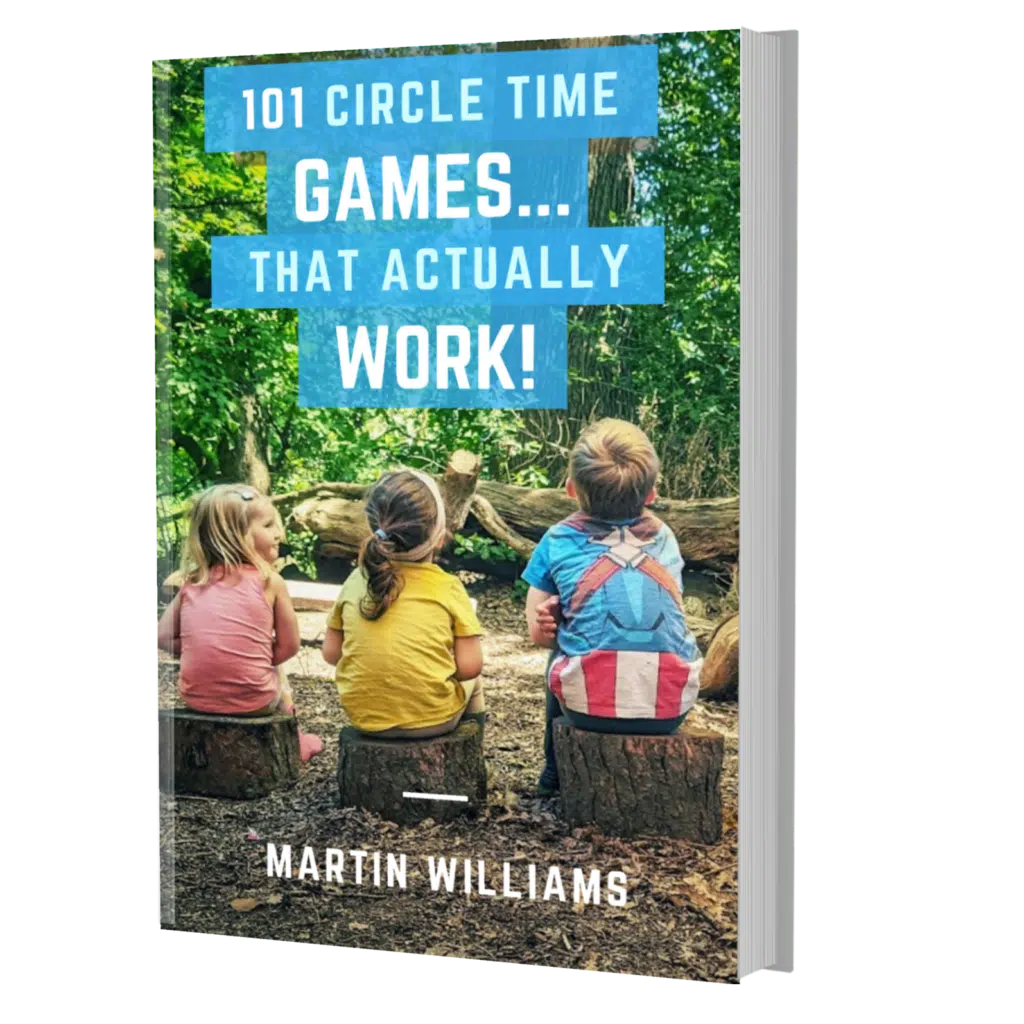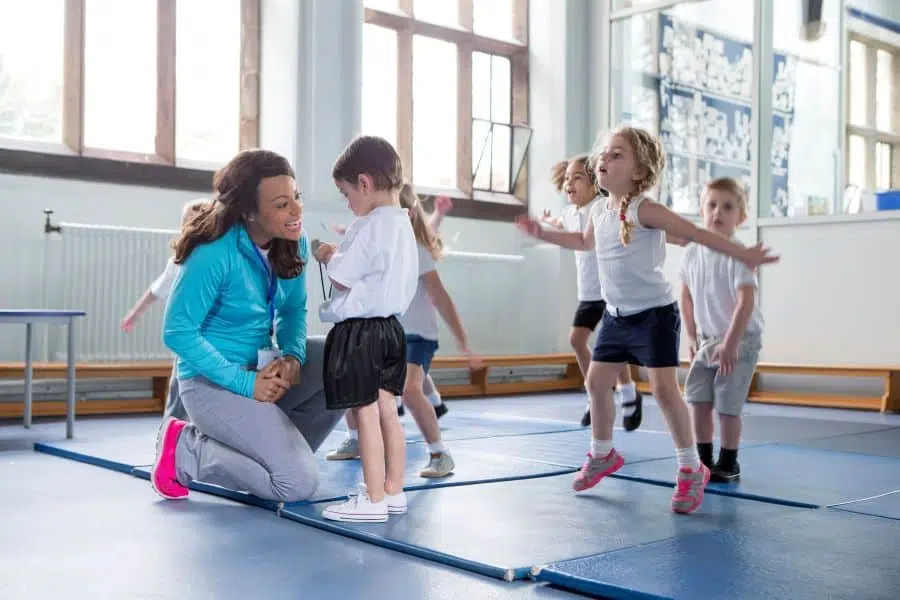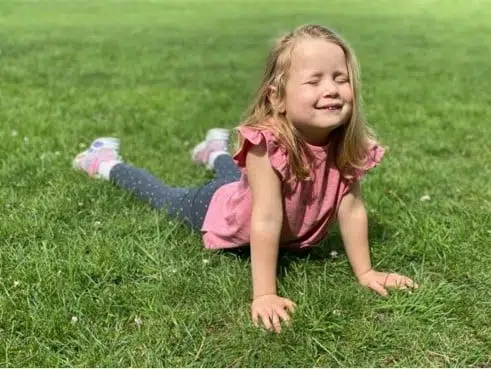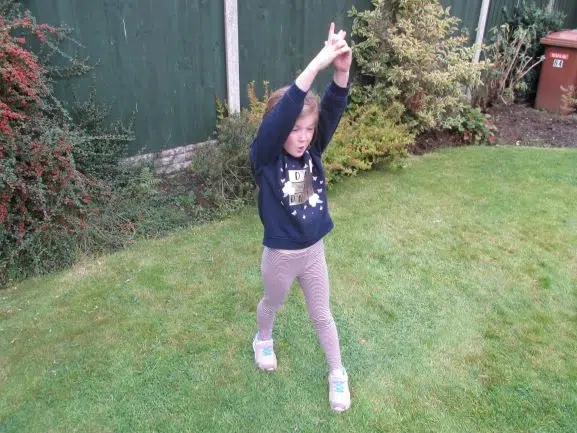P.E. lessons can be a bit daunting at times. All that equipment to organize and worry about. Yuck!
Then there are the safety aspects to consider. Eek!
The good news is, there are plenty of simple P.E. games that you can use with no equipment!
The Ultimate List of PE Games With No Equipment
Whether you need ideas for Kindergarten PE games, or PE games for preschool this list will spark the creativity you need for gym class or at home!
I’ve been teaching in early education for the best part of 20 years now, and in that time I’ve come up with a full armory of the very best PE games WITH NO EQUIPMENT! Woop!
That’s right! Just a group of children are enough to create many games and have plenty of fun.
All you need are a good space and plenty of energy, so let’s go!

1. Stop And Go Bubbles
Practice drawing a great big pretend bubble with your finger in the air.
Reach up as high as you can and reach down as low as you can. Really reach all the way around you.
If you can reach and touch anyone else with our moving your feet you are too close to move away and make sure you are in your own space.
Stretch out in your bubble to make sure you can’t touch anyone else’s just in case you should burst their bubble.
Ask the children to move like a bubble and float around the space. How freeing and mindful this bit is!
When you tell them to stop, make sure their bubble is in a good space so that no one can burst it.
2.Extra Sensory Perception (ESP)
This is a brilliant pairs game, that is good as a warm-up or as a fun game on it’s own!.
What you do is invent three movements and demonstrate them to the group.
Once you’ve played it a couple of times, the kids can come up with their own ideas.
Three examples of moves could be:
- Doing star jumps
- Doing Jazz hands
- Jumping a 360 spin on the spot
Then everyone gets a partner.
The true challenge now is to activate your ESP, which (as pretty much all kids seem to know), is your Extra-Sensory Perception. Simply put, this is the ability to read your partner’s mind (which is very exciting).
1,2,3!
Everyone displays one of the three moves at the same time. You want to do the move that you think your partner will do.
Do the same move? Woo woo! You activated your ESP.
Different move? Just try again.
Keep going for a few goes, before changing partners to see if your ESP works better or worse on other people.
As well as being a great PE activity, I often use this as a circle time game in class. This is one of the favorite games from my book 101 Circle Time Games…That Actually Work!

This book contains all the very best mindfulness circle games, active circle games, math games, literacy circle games, and so much more! You can check out the book here.
3. Foxes And Hares
Once the children have got a good understanding of space, and they can stop and start on your command, there are lots of fun PE games you can introduce.
Foxes and hares is a classic chase game.
Aim of the game: To catch all the hares of course!
About a fifth of the children should be foxes. So if you are playing with 10 children, 2 children can be foxes.
The hares move around the space by hopping. To hop, they should move both feet together and then put two hands together on the floor, just like a rabbit or a hare moves in bunny hops.
The foxes also move on four legs (hands and feet) but they should be quicker as they are less restricted.
To catch a hare, simply touch them (gently, please! No fox attacks).
When all the Hares are caught by the foxes, the game is over and you start a new game with a new group of foxes.
4. Trains and Tunnels
This is a similar version to the game above. There are always loads of train enthusiasts among pretty much any age of children, so this game is always a winner.
Choose a few children to be the trains.
Explain that the rest of the children are tunnels. They should make a tunnel by putting both their hands and feet on the floor and arching their back as high as they can to make a high tunnel with their body.
The trains should run around the space until you shout Whoo Whoo.
At the sound of the train whistle, they should crawl through as many of the tunnels as they can.
When a train has been through a tunnel, the tunnel is released and becomes a train.
Keep playing until all the tunnels are trains.
5. Shadows
This is a fun game for pairs.
One child is the leader, the other is their shadow.
Explain how your shadow does exactly what you do. It follows you everywhere, and your movements are identical.
As the leaders move around the space, the shadow follows and copies exactly what they do.
Encourage the children to use different levels of movement.
- Roll on the floor
- Move on your hands and knees
- Move on one or two feet
Encourage them to use different speeds of movement
- Move slowly and gracefully
- Move quickly and craftily
Encourage them to use different balances
- Balance on one foot
- Balance on all fours
- Balance on two feet and one hand
Remember to swap over so that both children have a chance to be the leader.
6. Good Toes Naughty Toes
This is another simple listening game requiring no equipment and it can be played as an indoor and outdoor game.
There are two instructions that the children are going to listen out for. Those are:
Good toes – They should stand completely still with their feet together
Naughty toes – They should dance around wildly using the space and not bumping into anyone else. (Music can be used if you want to)
This game is all about freedom and expression!

7. Noisy Running!
This is possibly my all-time favorite mindful PE game.
This is best done outside in a large space.
The idea is that the children are going to move and make noises at the same time. The volume of the sound they make will be directly linked to how fast they move.
Start by all humming very faintly, and walking really slowly.
Then try a fast walk, and raise the volume of the sound coming out of everyone’s mouth.
Then try light jogging, with a medium noise – aaaaahh – coming from everyone’s mouth, about the volume of talking.
Keep getting faster and increasing the volume! When you are running at full pelt, you will also be yelling as loud as possible – AHHHHH!
I like to do this activity in a structured way to introduce it and mix up the speeds/volumes for a while.
But then, for a couple of minutes, let the children ‘freestyle’. They choose their speeds and volumes and race around.
This activity is all about mindfulness, and experiencing a sense of freedom and liberation from inhibitions!
8. Floating!
Another mindful PE activity here.
Get the children to stand in a space and close their eyes. Then you are going to help them to visualize that they are transforming into something that floats or flies!
- A balloon
- A feather
- An eagle
It could be:
Let’s imagine we start with the balloon.
Tell the children to visualize they are slowly changing into a balloon. Their skin is becoming colored rubber. And now someone is blowing them up, and they are getting lighter and lighter, and larger and larger.
Then, tell them they are fully inflated.
The children open their eyes, and now they are going to imagine they are floating like balloons around the space!
Off they go – billowing and wafting in the breeze.
After a couple of minutes, you can try transforming into feathers or eagles.
9. Be The Teacher
This is a good way for children to start to think about the quality of their movements in PE class.
Work in pairs again. One child should be the teacher.
Explain that as the teacher, they have to help their pupil make the best quality moves and shapes that they possibly can.
It depends on what kind of moves you are working on, but I like to do this with gym moves.
Try moves like:
- Forward roll
- The splitz
- 360 jump rotation
Ask one child to demonstrate the move, and the other child should help them to make it perfect.
Encourage the children to be kind and helpful. For example, they might say things like:
Tuck your head in a bit more.
Can you straighten your legs even more?
Can you reach up taller?
Ask them to use lots of praise if they spot some good quality movements and make sure they tell their partner what they are doing well.
Don’t forget to swap so that everyone has a go at being the teacher.
10. Make A Shape
Put the children in groups of 4 or 5 and give them the challenge of working as a team to make a shape.
Explain that they can work on the floor, lying down or standing up, as long as the shape is clear.
Begin with the basic shapes of:
circle, triangle, square rectangle
Build up to more difficult shapes like:
stars, hexagons, ovals, rhombus, or octagon
11. Body Letters And Numbers
You can extend this from shapes to letters of the alphabet or numbers.
Simply ask the children to make a letter by working together to get into the shape. This is a good activity for team building as they will have to work together and everybody is needed.
12. Dance Like No-One’s Watching
Dancing is good for you for so many reasons. It’s a workout for the whole body, it encourages you to keep a beat and keep in time with music, and most of all, it’s fun.
It’s good for the soul, so put some happy upbeat music on and encourage some free dancing.
Clap your hands, wiggle your hips, wave your arms. Have fun!!
13. Heart Monitors
It’s important for children to know that exercising makes changes to our bodies so that they aren’t frightened by the changes and they understand what is happening to them.
This is a nice activity to explain those changes so that the children understand that it is perfectly normal.
Count down one minute of any kind of high-intensity exercise, for example:
- Fast running on the spot with high knees
- Tuck jumps with both feet together
- Pretending to skip on the spot as fast as you can
- Star jumps
- Burpees (lay down then jump up)
Really encourage the children to put lots of effort in here.
When the minute is up, encourage the children to put their hands on their hearts and feel it beating.
If they’ve put enough effort in, it should be pounding. Ask them to feel their forehead – it should be at least warm, if not hot and sweaty.
Notice how fast their breathing is when they stop. They should be out of puff.
With older children, you could ask them to take their own pulse before and after exercising and see how much their pulse rate has increased.
14. Eight Dance!
This is a great dancing game for kids of all ages.
Put some pumping music on to get everyone going!
Then pick some kind of action or dance move, and everyone does it eight times to the music while also counting at the same time – ‘1, 2, 3, 4, 5, 6, 7, 8!’
So, you might do eight star-jumps while counting. Or eight big marches on the spot.
Then shout out a new action, and start that, keeping the counting going throughout.
Some other good dances/actions could be:
- Jumps
- Arms up arms down
- Punch the air with one arm, then the other
- Arms wide, arms across your body
- Walking in place
For the older ones, the emphasis is on the movement. But for younger kids, this is also a great rote counting activity.
15. Animal Copy Cat
One child will be the leader in this game. This is the ‘cat’ that the others will try to copy.
The leader is going to pretend to move like an animal. Everyone else will copy!
For example, they might move like a monkey. They will stoop low, and swing their arms like a monkey. Everyone copies!
After a while, the leader will change the animal. They might pretend to be an elephant!
The trick is for everyone to watch for the transition and try to copy.
The leader can mix things up as quickly or slowly as they like.
16. Animal Freeze!
This is a variation of the animal copycat game above with a bit of music added.
Once again, have a leader that is going to pretend to be different animals that the others copy.
Put on some music, and the kids move around like the animal that the leader is demonstrating.
The adult will pause the music at any given moment. The children must then freeze in their best animal pose! It’s a bit like musical statues at this point. Anyone that moves could be out! (Or you can just play the non-competitive version where everyone gets to carry on each time).
17. Transformers
Wow – transformers are one of the most exciting things on the planet for many kids.
And this game really taps into this enthusiasm.
The kids are all now shape-shifting transformers. They can transform in the blink of an eye into many different types of vehicles, and move around the space like them.
Some good vehicles to try include:
- Train – with ‘chugging’ arms and lots of tooting!
- Helicopter – arms as rotas spinning over your head
- Racing cars – running around as fast as possible!
- Plane – Lots of swooping and soaring
- Monster trucks – Be as big and wide as you can
18. Mr Men/Little Miss Game
The idea of this is that the kids pretend to be some of the characters out of the Mr. Men and Little Miss books.
Some good ones to try include:
Mr. Grumpy – stamp around the room with your angriest face
Mr. Tall – Stretch up and walk as tall as you can
Mr. Bump – Go round bumping into walls and imaginary objects (though not other people)
Little Miss Tiny – Curl up like a tiny weeny ball
Lots of modeling of movements work well for this game – both from the adult and skillful children.
19. Child-Friendly Yoga
I find yoga is most effective with children when they can readily understand that the pose they are doing is mimicking something.
Some great poses that mimic things that children know are:
Household Yoga
In this, the kids mimic everyday actions in the house. It could be sweeping the floor, or washing the pots.
Seal Pose
Lie on your front, with your hands flat on the floor next to your face.
Push upwards until your arms are straight, your chest is off the floor, and your back is arched.
This stretches the back and abdomen.

Giraffe Pose
Stand with one foot in front of the other.
Reach up high with both hands (this being the giraffe’s neck.) Then slowly bend down, and touch your leading foot with both hands.
Then slowly return to the original position.

Turtle Pose
Lie on your back. Pull your knees into your chest so that you form a ball shape. Slowly rock backward and forwards.
Your curved back forms the turtle’s ‘shell’.
20. Bean Game
This is one of those all-time classics that I thought I should include on this list.
The children pretend to be types of beans, each of which has its own separate movement.
Model two or three bean movements to start off with, have a practice, and then all play the game. Add more bean movements when the children get more confident.
The adult simply calls out a bean name, and the children move in that way.
The beans and associate movements are:
Sprouting bean – Walk around on your tip-toes, with your arms stretched as high above you as possible
Baked bean – Sit down on the floor
Broad bean – Try to be as wide as possible! Walk around like this
Beans on toast – Lie down on the floor
Chilli bean – Shiver! This is a ‘pun’ on the word ‘chilli/chilly’ (obviously!)
Jelly bean – Wibble and wobble!
Runner bean – Run around like crazy
French bean – Say, ‘Bonjour!
When you’ve played a few times, a child could potentially become the leader of this game.
21. Action Stories
This is a really good way of combining storytelling, listening, and action!
The adult makes up a story, and the children act it out.
After you’ve done it a few times, a confident child might well be able to lead this.
You want to have lots of active characters in the story, such as stamping giants, witches on broomsticks, unicorns galloping, and all that kind of thing.
As well as that, it’s good to have lots of action, such as terrible storms blowing, landslides, sinking sand, and all the rest of it.
The kids act all of these things out.
A sample start of a story might go:
‘One day the giant went stamping off through the forest. A terrible wind began to blow. The trees were swaying from side to side. Suddenly a unicorn came galloping into the forest to save the giant…’
I’m sure you get the picture!
22. Traffic Lights
Here’s another absolute classic of the repertoire!
In this, the children will pretend to be cars, and the adult gives different verbal instructions that the cars respond to.
The easiest way to play the game is to have three simple instructions that correspond to the colors of a traffic light:
Green – Go! Jog around the space
Red – Stop still
Yellow – Walk on the spot, ready to go
Start easy, but you can always add more elements to the game when they are ready. Some other verbal cues include:
Honk the horn – A noisy one, this! Go round tooting!
Roundabout – Jog around in a narrow circle
Parking Lot (or car-park) – Lie down on the floor
Freeway – Run as fast as you can
23. Fox and Chickens
This is a variation of a basic tag game.
The idea is to mix up the game by incorporating a theme that the children are interested in.
So, you could have a fox catching chicken by tagging them. Or one of the following:
- A shark catching fishes
- A bird catching worms
- Or a witch catching children
Anything you think the children will respond to is fine.
24. HIIT Session
Here is a simple idea, that is great for fitness for all ages.
You have a structured sequence of activities that you perform together. Spend about thirty seconds on each movement, with a fifteen-second break.
Some simple moves include:
- Reach up, reach down
- Jumping like a frog
- Jumping in place
- Hopping
- Star jumps
- Reach to one side, reach to other
For older or more skillful children, you can try some of these:
- Press-ups
- Squats
- Sit-ups
- Burpees
- Star jumps
You can do one round of the activities or even two or three reps!
25. Simon Says Active Version
Of course, you all know the basic idea of Simon Says.
But it works really well in PE sessions if you make the moves super-active!
So, rather than ‘Simon says touch your nose’ kind of instructions, you want to think more along the lines of ‘Simon says crawl like snakes across the floor!’
Some other good examples might be:
‘Simon says wade through the muddy swamp.’
‘Simon says climb the rope ladder.’
‘Simon says run like a cheetah on all fours!’
26. Captain’s Coming
This is another game that is donkey’s old, but children love it generation after generation.
All the kids pretend to be on a boat. The adult gives orders to the ‘crew’.
These include:
Scrub the deck – Get on hands and knees and start scrubbing the floor!
Swim to shore – Use a powerful front crawl to move around the space
Into the hammock – Lie down on the floor
Lift the cannonballs – Lift up those super heavy cannonballs, and load them into the cannon!
Row the boat – Row!
Captain’s coming – Salute!
27.Melting Moments
This is a visualization and mindfulness game that is great as a warm-down.
The children are going to be imagining that they are something that melts. For example, they could be:
-A snowman
-A chocolate bar
-An ice-cube
Let’s imagine we go for ‘snowman’. Tell the children to stand in a space and then close their eyes.
Tell them to imagine that they are transforming into a snowman. They can feel their freezing cold body, their carrot nose, and coal for their eyes.
But now the hot sun has come out. You can feel the warmth on your face!
Feel how the snow is melting your body. Water is starting to drip down the snowman.
Imagine you are shrinking! You are getting lower to the ground! And finally, you are a steaming puddle lying on the floor.
(Ask the children to lie down and imagine this!)
28. Figures Of Eight
This is a good game to use as a warm-down.
The basic idea is that the kids stand in a space, and they are going to form a large figure 8 in the air with different parts of their bodies.
Start with their finger, but then move on to using their:
- Elbow
- Foot
- Head
- Knee
- Nose
- Belly
- Eyes
Warming Up And Cooling Down
To warm-up before PE Class or a fun activity at home, I like to play some music with a good steady beat and perform some repetitive actions for the children to copy. I make sure I warm up my arms, shoulders, feet, legs, hips, and neck.
To cool down after PE games, try some nice long stretches for all the different body parts. I always like to finish a cool-down with some big deep breaths. Scoop up some air, stretch up and hold it above your head and then blow it away as you release your arms back down to your sides.
Not Just Good For Physical Learning
One of the biggest benefits of daily physical activity is that children’s behavior improves as well as their overall confidence and independence. Check out this study on tracking of physical activity into into adulhood for more information on the benefits of PE Games.
Now that’s something worth trying for.
Good luck if you try out any of these fun PE games!
